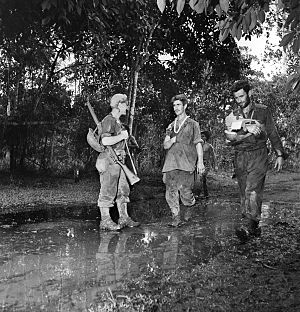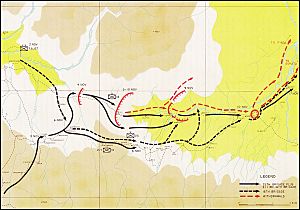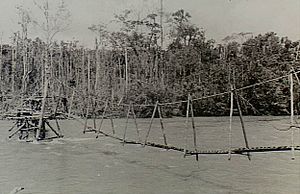Battle of Oivi–Gorari facts for kids
Quick facts for kids Battle of Oivi–Gorari |
|||||||
|---|---|---|---|---|---|---|---|
| Part of the Second World War, Pacific War | |||||||
 Australian wounded return to a dressing station around Oivi, November 1942 |
|||||||
|
|||||||
| Belligerents | |||||||
| Commanders and leaders | |||||||
| Units involved | |||||||
|
7th Division
|
South Seas Detachment
|
||||||
| Strength | |||||||
| 3,700 | 2,800 | ||||||
| Casualties and losses | |||||||
| 121 killed 225 wounded |
430 killed 400 wounded |
||||||
The Battle of Oivi–Gorari was a major fight during the Kokoda Track campaign in Papua New Guinea. It happened from November 4 to 11, 1942. This battle was the last big fight before the important Battle of Buna–Gona.
After Australian soldiers took back Kokoda on November 2, they started getting fresh supplies. Airplanes flew in food and ammunition. This helped solve problems that had slowed their advance. It also allowed them to push the Japanese back.
On November 4, the Australians moved forward again. They headed towards Oivi along the Kokoda–Sanananda Track. At Oivi, the lead Australian group, the 16th Brigade, met strong Japanese defenders. These Japanese soldiers were part of the South Seas Detachment. They wanted to stop the Australians from reaching the coast.
For several days, the Japanese fought hard. They stopped many direct attacks. This forced the Australian commander, Major General George Vasey, to try a different plan. He decided to go around the Japanese from the south. Another group, the 25th Brigade, went around Oivi on a different path. They then turned north and attacked the Japanese at Gorari. There was intense hand-to-hand fighting. Both sides had many losses. Finally, the Japanese pulled back to the east. They crossed the Kumusi River, which was flooded. Many Japanese soldiers drowned, and they had to leave behind a lot of their big guns.
Why did the Battle of Oivi–Gorari happen?
The Second World War was happening, and Japan wanted to expand its control. On July 21, 1942, Japanese forces landed near Buna and Gona in northern Papua. Their goal was to capture Port Moresby. They planned to march there along the Kokoda Track. This plan came after a sea attack failed in May during the Battle of the Coral Sea.
For three months, Australian soldiers fought to slow down the Japanese. The Japanese moved steadily south towards Port Moresby. But then, Japan faced problems in other battles, like at Milne Bay and Guadalcanal. Also, a big battle at Ioribaiwa in early September stopped their advance. The Japanese supply lines were stretched too thin. They were told to stop attacking and defend their positions. So, they started to retreat north over the Owen Stanley Range mountains.
Throughout October, the Australians tried to take control of the fighting. US airplanes helped by bombing Japanese supply routes. There were tough battles at Templeton's Crossing and Eora Creek. Progress was slow for the Australians. Their commander, Major General Arthur Allen, was replaced by Major General George Vasey.
Finally, on November 2, Australian troops from Brigadier Kenneth Eather's 25th Brigade secured Kokoda. Taking back Kokoda was very important. It gave the Allies an airfield where supplies could be flown in. This made it much easier to get ammunition and food to the soldiers. It also meant wounded soldiers could be flown to Port Moresby faster. This greatly improved their chances of survival.
How did the Battle of Oivi–Gorari unfold?
After a short break to get more supplies, the Australian advance continued on November 4, 1942. Major General Vasey's 7th Division led the way. Brigadier John Lloyd's 16th Brigade took the lead. They moved north from Kobara towards Pirivi, then east towards Oivi. The land was flat and hot, making the advance slow.
The Australians pushed along the narrow track between Kokoda and Sanananda. They were stopped at Oivi by a strong Japanese force. The Japanese had built very good defenses. About 3,700 Australian soldiers from the 16th and 25th Brigades faced about 2,800 Japanese soldiers. These Japanese were from the 41st Infantry Regiment and 144th Infantry Regiment. They were part of General Tomitaro Horii's South Seas Detachment. The Japanese also had 15 mountain guns and 30 heavy machine guns.
The Japanese positions were well hidden and strong. They used palm logs and had snipers in trees. They had built these defenses over several weeks and were determined to hold their ground. The Australians had not had much artillery during the campaign. But now, with the airfield at Kokoda, they had plenty of mortar rounds.
The 16th Brigade tried several direct attacks on Oivi. But the Japanese fought them off with heavy artillery fire. So, General Vasey decided to try a flanking move towards Gorari. He moved the 25th Brigade forward from Kokoda. Two Australian battalions, the 2/2nd and 2/3rd Infantry Battalions, along with the 3rd Infantry Battalion, kept the Japanese busy at Oivi.
Meanwhile, the 2/1st and the three battalions of the 25th Brigade (2/25th, 2/31st, and 2/33rd Infantry Battalions) made a wide move around Gorari. They went through Kobara and Komondo.
On November 6, the 2/1st tried to go around Oivi by moving east on a parallel track. They were looking for a track north to Gorari at Waju. They missed it at first in the thick jungle. They lost a day finding their way back. On November 7, the 2/1st found the track and joined the rest of the 25th Brigade. They started moving north.
The Japanese sent two battalions from the 144th Regiment south to Baribe. This was halfway along the Waju–Gorari Track. They wanted to block the Australians. On November 8, the 41st Infantry Regiment at Oivi was heavily bombed by US planes. So, one battalion of the 144th pulled back from Oivi to protect Gorari.
On November 9, two Australian battalions started to surround the Japanese at Baribe. Two other battalions went past them towards Gorari. There was fierce hand-to-hand fighting. The 2/31st and 2/25th fought at Baribe. The 2/33rd attacked Gorari from the west. The 2/1st attacked from the east and fought near Horii's headquarters. Parts of the 2/31st also pushed further east to cut the track on November 11.
The Australians were closing in on the Japanese at Oivi. The Japanese were running low on ammunition and food. General Horii ordered them to pull back. On the night of November 11/12, the remaining Japanese forces broke away. They tried to escape across the Kumusi River. In the confusion, the 144th Infantry Regiment did not get the order. They had to fight their way out, losing many soldiers. The commander of the 41st Infantry Regiment, Yazawa, decided to cross the flooded Oivi Creek and head for the coast.
The Australians continued their chase as the Japanese retreated north. The Australians reached the Kumusi River near Wairopi on November 13. Here, the Japanese had to leave behind most of their artillery, ammunition, and other supplies. This battle effectively ended the main part of the Kokoda Track campaign.
What happened after the battle?
The fighting at Oivi and Gorari was the last big battle of the Kokoda Track campaign. But the fighting in the area did not completely stop. The wire bridge at Wairopi had been destroyed by Allied bombing. So, from November 13 to 15, Australian engineers worked to build ways to cross the river. They made makeshift crossings, including flying foxes and a narrow footbridge. This allowed a small group of soldiers to cross first.
Crossing the river was slow because they had limited supplies. It wasn't until November 15 that the 25th Brigade finished crossing. Then the 16th Brigade followed. Meanwhile, patrols searched for any Japanese soldiers left on the west side of the river. More Australian soldiers arrived to help the 25th Brigade. By late November 16, the Australians had finished crossing. They continued to chase the retreating Japanese.
The Japanese soldiers who survived the Kokoda campaign gathered at the mouth of the Kumusi River. They met up with more Japanese soldiers who arrived in early December. The next few months saw very heavy fighting on the northern coast of Papua. This was around Buna and Gona. The Allies launched costly direct attacks against the heavily fortified Japanese beach defenses.
The Australians had 121 soldiers killed and 225 wounded at Oivi and Gorari. Many more soldiers got sick from diseases. The Japanese lost about 430 killed and 400 wounded. They also lost a lot of war equipment, including 15 artillery pieces. Many Japanese soldiers also drowned while trying to cross the Kumusi River, which was up to 100 meters wide in some places. General Horii himself drowned while trying to cross.
Some historians believe Horii made a mistake by choosing to fight at Gorari. The land beyond the Kumusi River might have been better for defense. However, others say the Japanese defense was "skillful and determined." It made the Australians fight very hard for their victory. Also, the Japanese retreat helped slow down the Australian advance. This gave Japanese engineers time to build strong defenses around Buna, Gona, and Sanananda.
After the war, Australian units received a special award for their part in the fighting at Oivi and Gorari. It was called "Oivi – Gorari." This award went to the 3rd, 2/1st, 2/2nd, 2/3rd, 2/25th, 2/31st, and 2/33rd Infantry Battalions.




